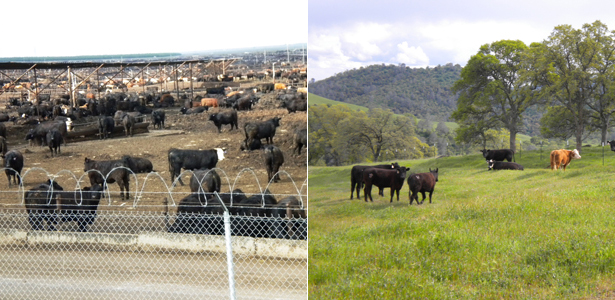Butcher Given Acre to Produce Beef Crossword
Feedlots vs. Pastures: Two Very Different Ways to Fatten Beef Cattle
Raising cattle on pasture is inherently more challenging than fattening them on feedlots, but the results are worth the extra effort.

Before buying your next cut of beef, consider these two photographs.
The first is of the Harris Ranch Beef Company feedlot along Interstate 5, about halfway between Los Angeles and San Francisco. There, up to 100,000 cattle at a time are crowded on top of their own excrement into one square mile of what can be euphemistically called mud (winter) or dust (summer). From the highway, the stench wallops you like a punch in the face and lingers in your car and clothing (even if you never stop driving) for miles -- and in your memory forever. Critics call the Harris feedlot Cowschwitz.
Harris gained a flicker of national fame two years ago when its chairman, David Wood, wrote a letter (PDF) to the president of California Polytechnic State University threatening to reconsider "financial support" for the college unless it cancelled a solo lecture by Michael Pollan, who was critical of feedlots in his book The Omnivore's Dilemma, a position in part inspired by driving past Harris' facility. Money talked, and Pollan was relegated to being part of a panel discussion.
Most of the beef consumed in the United States comes from such feedlots, where cattle arrive after living for six months on pasture and grass to be finished for another six months or so on a diet of corn and other grains. Because a diet mainly made up of corn wreaks havoc on the digestive systems of cows, which are ruminants and designed for grass not grain, they are fed daily rations of antibiotics.
The second photograph was taken across the valley from Harris' feedlot in a pasture leased by Open Space Meats. Those cows will stay on pasture eating grass for their entire lives, "doing what God intended a cow to do," said Seth Nitschke, who owns Open Space with his wife, Mica. When I visited, Nitschke was at the ranch for one of his weekly inspections to see that all was well with his cattle and to check on their rate of weight gain.
From the crown of his worn Stetson to the pointy toes of his boots, Nitschke is a cowboy. He often checks his cows on horseback, but that day his steed was a mud-splattered all-terrain vehicle. I jumped on the back and held on for dear life as the contraption bucked, heaved, and lurched across streams and blasted through steep, rock-strewn pastures and stands of oaks where the flat valley floor gives way to the foot hills of the Sierra Nevada.
Raising beef cattle on pasture is inherently more challenging than fattening them on feedlots. Nitschke's first problem was one the folks at Harris never face. There was no sign of any of the 75 cows that called the 1,100-acre ranch home. Near the stone foundation of an old forty-niner's shack, Nitschke cupped his hands to his mouth and issued an impressively authentic moo.
A 1999 graduate of California Polytechnic, Nitschke is no stranger to the feedlot beef business. After graduating, he became cattle buyer for Excel Fresh Meats (part of the agricultural giant Cargill), where he purchased 150,000 animals a year. But when the time came to strike out on his own, he did an about-face.
"The way I raise my cattle," he told me, "is more expensive and takes longer." His cows go to slaughter at between 18 and 24 months of age versus 14 months for a feedlot animal. "But grass is a wonderful thing. Cows eat it. They get fat, and I produce a better product. They aren't maxed out to all their livers can handle. We don't need hormones or antibiotics."
Nitschke let out another bellow, and this time a few dozen stocky black and brown cows reluctantly emerged from the forest. "The real cowboys say that I'm producing 'hippie chow,'" he said, in a drawl that would be at home on any range. "But I have a whole lot of customers who love what I do -- and I sleep well at night."
We get our beef from LaPlatte River Angus Farm, which raises a few hundred head a year on pastures near our Vermont home. Perhaps because of my British heritage (via Canada), we faithfully observe Boxing Day, which wouldn't be Boxing Day without a standing rib roast and Yorkshire pudding. But this year, when we placed our order, the grocer said that all the LaPlatte roasts had been spoken for weeks earlier. All he could get was "Western beef." Images of Cowschwitz flooded into my mind -- and nostrils -- and I demurred. Then, after rechecking his supply, the meat man corrected himself. There was one unclaimed LaPlatte roast.
Our beef can't measure up to Nitschke's standards. Although the cow that produced it never received antibiotics and grazed on fields for 12 or 15 months, it joined about 80 comrades at LaPlatte's "home farm" for a couple of months to fatten on corn and hay. Not perfect, but with the help of a big Rhône red, I was able to swallow it.
Images: Barry Estabrook.
trenwithtwiletionly.blogspot.com
Source: https://www.theatlantic.com/health/archive/2011/12/feedlots-vs-pastures-two-very-different-ways-to-fatten-beef-cattle/250543/